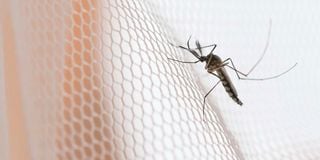Premium
WHO asks countries to issue new malaria bed nets

A mosquito on a bed net. The World Health Organisation (WHO) has advised malaria-endemic countries to roll out new malaria bed nets to fight malaria resistance.
The World Health Organisation (WHO) has advised malaria-endemic countries to roll out new malaria bed nets to fight resistance. The international health body now recommends the use of malaria bed nets that have been treated with new insecticides in areas with parasite resistance.
For years, countries including Kenya have been using insecticides known as pyrethroids in treating mosquito nets.
But WHO now says the insects in many countries have become resistant to routine use of pyrethroids.
After a successful trial of new insecticides, Pyrethroid-chlorfenapyr nets combine a pyrethroid and a pyrrole insecticide to enhance the killing effect of the net and Pyrethroid-pyriproxyfen nets combine a pyrethroid with an insect growth regulator (IGR).
The IGR disrupts mosquito growth and reproduction. The WHO is now asking countries to adopt the new nets in the trial conducted in Tanzania and Benin. Insecticide-treated bed nets are key tools for malaria prevention.
Both trials have shown a significant reduction in malaria infections compared to the standard pyrethroid bed nets.
In Tanzania, malaria prevalence was reduced in children that received the pyrethroid-chlorfenapyr-treated bed nets at 26 per cent, compared to 49 per cent in those that received pyrethroid-only bed nets, after 24 months.
In Benin, after 18 months, malaria prevalence stood at 28 per cent in the group that received pyrethroid-chlorfenapyr-treated bed nets compared to 39 per cent in the group that received pyrethroid-only bed nets.
The new recommendations published in the WHO Guidelines for malaria are asking countries to roll out new nets.
“These new types of nets were designed to have a greater impact against pyrethroid-resistant mosquitoes. By including two active ingredients in an insecticides- treated net, the likelihood of mosquitoes being resistant to both is greatly reduced,” Dr Jan Kolaczinski, who leads the Vector Control and Insecticide Resistance Unit within the WHO Global Malaria Programme said.
He said that compared to pyrethroid-only nets, pyrethroid-chlorfenapyr-treated nets should have an increased killing effect against pyrethroid-resistant malaria vectors and, thus, a greater impact against malaria.
According to WHO’s latest World Malaria Report, the emergence and wide geographic spread of pyrethroid resistance among malaria-transmitting mosquitoes is a threat to the effectiveness of nets.
Since 2005, over two billion insecticide-treated nets (ITNs) have been distributed worldwide to prevent malaria. All of these nets were treated with only one insecticide class pyrethroids. However, as mosquitoes in many areas are now resistant to pyrethroids, nets treated with other active ingredients are needed to control malaria.
Over the last two decades, treated nets have contributed significantly to reduction of malaria cases worldwide. In Kenya, millions of insecticide-treated bed nets have been distributed.
In 2000, Supanet, a treated mosquito net, was launched in Kilifi. It was a new form of intervention as existing nets were not treated.
In April 2001, there was a rebrand as Supanet introduced a retreatment kit dubbed Power Tab. The tablet would be dissolved in water before the net was dipped in. Soon after that, long-lasting insecticide-treated nets were developed.
Kenya began distributing treated nets in malaria-endemic regions in partnership with the WHO to test their effectiveness. In 2007, based on the promising results from Kenya, the WHO issued global guidance on the use of treated mosquito nets.
In July 2021, 15.7 million insecticide-treated mosquito nets were distributed in 27 high malaria burden counties. However, the threat still persists.
Malaria remains the second biggest cause of reported deaths after respiratory infections, with nearly 70 per cent of the country’s 46 million people at grave risk. Every year, the country reports nearly 3.5 million new clinical cases and 10,700 deaths.
With the introduction of the vaccine called RTS developed by the pharmaceutical giant GSK and proven effective six years ago, malaria cases fell nationally from a prevalence of eight per cent in 2015 to 5.6 per cent in 2020.
In the lake regions, the prevalence has since dropped from 27 per cent in 2015 to 19 per cent in 2020 and from eight per cent to 4.5 per cent currently at the Coast — almost 50 per cent reduction, according to the Malaria Indicator Survey 2020.




